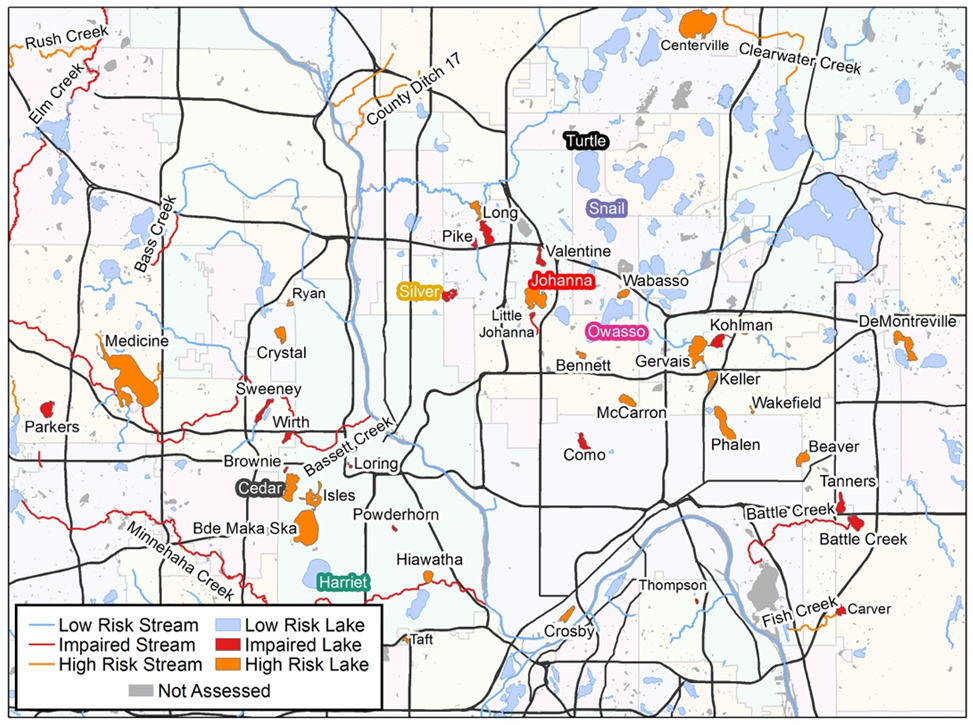Even after the winter’s snow has melted, our lakes and streams will not forget what we have done to move about at summer speeds during the winter months. Salt we apply to our streets, parking lots, and sidewalks is a pollutant that permanently stays in lakes, streams, and groundwater.
 Remember your first taste of ocean water? In urbanized areas the first flush of meltwater in early March is two-to-three times as salty as ocean water. It’s easy to float in the ocean because salty water is more dense than fresh and sinks to the bottom. In freshwater lakes it does the same thing, where it wipes out the creatures that live near the bottom.
Remember your first taste of ocean water? In urbanized areas the first flush of meltwater in early March is two-to-three times as salty as ocean water. It’s easy to float in the ocean because salty water is more dense than fresh and sinks to the bottom. In freshwater lakes it does the same thing, where it wipes out the creatures that live near the bottom.
This is not a case of fish going belly up immediately. The sensitive species in our lakes are the invertebrates and insect larva that live near the bottom. They form the base of the food chain and when they die off, the creatures higher up on the food chain, including fish, can’t find food.
 Right now, the lakes most polluted with salt are confined to the metro but as development reaches farther out, more lakes will be threatened. This isn’t a hypothetical argument — some metro lakes already do not meet the standard to be considered “freshwater”, such as Silver Lake in New Brighton. Others, such as Lake Johanna in Arden Hills and Cedar Lake in Minneapolis will follow soon. Many more are safe for now — Harriet in Minneapolis and Owasso, Snail, and Turtle in Shoreview — but without changes to our salt diet, these lakes will suffer the same fate.
Right now, the lakes most polluted with salt are confined to the metro but as development reaches farther out, more lakes will be threatened. This isn’t a hypothetical argument — some metro lakes already do not meet the standard to be considered “freshwater”, such as Silver Lake in New Brighton. Others, such as Lake Johanna in Arden Hills and Cedar Lake in Minneapolis will follow soon. Many more are safe for now — Harriet in Minneapolis and Owasso, Snail, and Turtle in Shoreview — but without changes to our salt diet, these lakes will suffer the same fate.
Salt is toxic, but useful in small amounts for public safety. We are all part of the problem with over applying it, and all part of the solution, too. The top five things you can do now:
- In winter, drive for the season. Our collective demand for perfectly-cleared roads is a major barrier to protecting our lakes.
- Ask your city council what they are doing to minimize salt usage on public roads.
- Tell your legislators you support bills that incentivize maintenance firms to apply less salt on private properties (like HF 3577 and SF 3199).
- Hire maintenance firms that have taken salt application training for your business or homeowner association properties.
- Keep your personal use down by removing snow quickly and minimizing salt use to about one coffee mug for a typical driveway, only as necessary. Clean up any leftover salt, sand, and de-icer to save and reuse as needed.
— Brian Bohman, Freshwater policy intern and University of Minnesota PhD candidate
Data on lake chloride concentration, chloride impairments, and risk chloride impairment are from MPCA. Additional high risk lakes were identified by identifying lakes where MPCA monitoring data suggests mean annual chloride concentration will exceed 230 mg Cl/L within 50 years.
I am so glad that more organizations are making this a priority for discussion and action. Legislation like that proposed has had success in other areas of the country. Great blog!
Hi Brian
Good article
Where did you get your charts ?
Second chart when was the data taken that populates this chart?
Thank you and keep up the good work